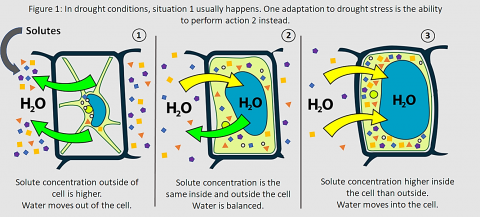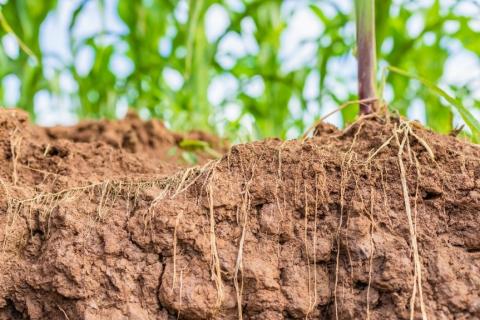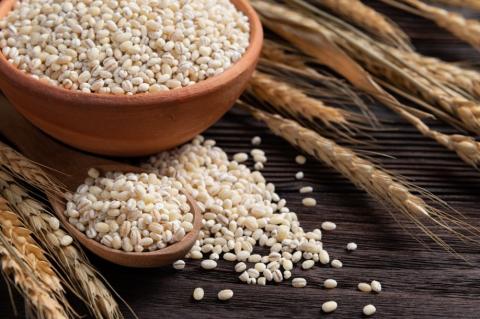28 April 2020
Dr Cate Williams: IBERS, Aberystwyth University.
- Developing drought-resistant crops is a key strategy for farmland adaptation to climate change and will help to improve global food security.
- Drought resistance is a complex trait that involves many different genes, making it difficult to manipulate.
- New sequencing technologies could be the key to creating new, drought-resistant and high-yielding cultivars.
- There are a variety of management decisions that may help farmers to deal with drought, e.g. rainwater harvesting, succession planting or switching to winter crops.
Climate change is a defining issue that has far-reaching consequences for all life on planet earth. One result of climate change is the occurrence of extreme weather (heatwaves, drought and flooding) and changes in temperature and precipitation patterns. As a result, the frequency and severity of drought, heatwaves and flooding are predicted to increase and pose a direct threat to food security across the globe. There are two approaches to addressing climate change: adaptation (coping with the effects of climate change) and mitigation (reducing the factors contributing to climate change). Within the agricultural industry, a variety of interventions are being explored to cope with the effects of climate change and to also mitigate future contributions. Selective breeding of crops, and indeed animals, is an essential part of the adaptive response. Resistance to drought (and associated conditions such as heatwaves) and flooding are the most common climate-related traits for which crop varieties are bred, with the view to coping in extreme weather and improving global food security.
Mechanisms of drought resistance
In general, plants have a wide range of adaptive mechanisms to cope with drought conditions, with different species and cultivars displaying different responses. Many different drought tolerance and avoidance strategies come together to give a drought-resistant plant. Drought avoidance strategies aim to minimise the effects of drought mostly through reducing water loss, for example, changing the number of stomata and/or the size of these openings. Stomata are microscopic pores mainly found on leaves that allow for gas exchange, reducing the number or closing them can also reduce the chance of water loss. Other traits include increasing levels of cuticle wax, rolling of leaves to reduce the overall surface area or changing leaf orientation, all of which work to prevent water loss.
On the other hand, drought tolerance refers more to how the plant copes with the effects of drought, particularly on a cellular level. Often this involves the production of hormones and chemical compounds that balance the movement of water in and out of the cell and maintain a healthy cell membrane (figure 1). Also known as ‘osmotic adjustment’ a plant can control the flux of water through the concentration of solutes inside the cell down to minuscule levels (figure 1). This helps to maintain the correct amount of pressure inside the cell and a healthy cell membrane, which in turn keeps plant tissue healthy and avoids necrosis (often seen as ‘browning’).
Another function of these hormones and chemicals that are released in response to stress is in detoxification, as the plant goes through stress (drought or otherwise) toxic compounds can build up, it is, therefore, essential that these toxins are discarded. This also helps to maintain a stable environment for enzymes and molecules that play a role in essential metabolic processes and contribute to plant health, growth and development.
What is arguably the key physical attribute in drought resistance is root length and depth. Roots are essential in growth, development and performance due to their instrumental role in water and nutrient uptake. The root system is flexible and dynamic which allows plants to respond to drought by promoting root growth and development. Whilst root depth and density are key players in drought resistance, the hydraulic capacity of the roots (i.e. their ability to extract water) is equally as important. Root structure is heavily influenced by environmental conditions but there is also some genetic basis for the trait. Enhanced root structures can also play a role in mitigating flooding. Deep and well-developed root structures allow for enhanced infiltration by water - through gaps created by the plant roots rather than flowing over the surface. Plant roots also contribute to the physical structure of soil which may reduce flooding potential. Soil compaction is also important in root development and flood mitigation, as high levels of compaction restrict root growth and reduce the water holding capacity of the soil. This limits the supply of water to the plant itself and may also contribute to the risk of flooding.
It is important to note, that each plant species is different and even cultivars within species will show different adaptive mechanisms to drought – using all, none or some of the above strategies. However, these adaptations have a strong genetic basis making drought resistance an attractive candidate for genetic manipulation and selective breeding programmes. Hundreds of genes involved in drought resistance have been identified and it is agreed that the ‘resistant’ phenotype is controlled by many, small-effect genes that control a huge variety of different responses.
Case studies
Grass
The most utilised grass cultivar in the UK is ryegrass, as it is highly productive and well-suited to the local climate and farming systems. Perennial ryegrass (PRG) is perhaps the most popular as it is versatile persistent and long-lived. Whilst PRG boasts good cold tolerance, it is not as well equipped to handle arid conditions.
Research comparing PRG varieties from many different countries has identified differences in genes linked to drought resistance. For example, a cultivar from Norway displayed 7x higher shoot matter than the control PRG after extended drought conditions, resulting in high yields as well as resistance to drought. North African ryegrass has also been evaluated due to its deep rootedness; however, further research found a reduction in summer productivity. This is likely an effective adaptation to arid African summers, but it may hamper performance in the UK. Spanish cultivars, on the other hand, appear to maintain summer yields whilst displaying drought-resistant characteristics, so may be a better option for crossing with domestic varieties. Whilst many genes have been identified and manipulated in PRG with success, looking to strains from arid countries may hold further answers. Crossing varieties with others that display desired levels of drought resistance whilst maintaining yield may be preferable to targeted genetic manipulation.
The SuperGraSS project carried out at IBERS in Aberystwyth University found that a PRG x fescue hybrid (Festuca pratensis) produced stronger roots that were better able to penetrate compacted soil, when compared to PRG (Lolium perenne). Such root structures have the potential to increase soil porosity, water holding capacity and may contribute to reducing flood risk as a result. When compared to a standard PRG variety, the Festulolium sp. reduced run off by 51% and by 43% when compared to meadow fescue. The SUREROOT project now aims to build upon this work and explore the effects of drought as well as flooding. A recent experiment supports and develops upon this result, finding that following drought stress, tetraploid PRG populations (and a small number of Festulolium and Festuca sp.), were able to develop more shoot and root dry matter than diploid populations. The onset of drought-related symptoms was also delayed, and the plants recovered better once drought conditions were relieved. Such research tentatively suggests that tetraploid PRG may be better equipped to deal with drought than diploid varieties.
Barley
Barley is another important UK crop, predominantly planted in spring and ready for harvest in summer, although in some cases it is planted in late autumn. The yield of spring barley can be affected by drought conditions in both spring (seedling stage) and summer (flowering stage) as it is poorly adapted to life in arid climates. As such, the improvement of productivity under drought conditions is important – particularly at the seedling stage when the plant is most sensitive.
Research suggests that in barley the movement of gas through the stomata and levels of chemicals (sodium and potassium) inside cells are more important than root length and the density of stomata in the leaves. Interestingly, this evidence indicates that barley relies more on osmotic adjustment at a cellular level than larger changes in morphology like root length. Such adaptations fall into the category of drought tolerance and may guide future breeding strategies.
Several genes involved in drought resistance in barley have been identified and explored. One key gene is HVA1, which shows a linear relationship with drought response – the more highly expressed the HVA1 gene is, the better the drought resistance of the plant. Another promising candidate is the HvP5CS1 gene, variations of which are associated with good drought resistance. Both genes may serve as useful DNA markers for genome-assisted breeding projects.
Oats
Another predominantly spring crop, oats are a key crop around the world. Oats are versatile and perform well on a variety of soils, including ones of marginal quality, however, they are sensitive to arid climates. Whilst the current temperate climate of the UK suits oats as a crop, this may well change in the future.
Research from Aberystwyth university using new sequencing technologies suggests that closing of the stomata and antioxidant action are key adaptations for oats under drought stress. In the drought-resistant cultivar, these mechanisms were activated rapidly, before the effects of drought were able to cause damage, suggesting that drought-resistant oats practice drought avoidance, rather than tolerance.
The oat cultivars Brusher, Tarahumara and Paisley have shown good drought resistance properties in studies in Iran, whilst the cultivar Patones has also shown promise. Such tests may form the basis of new breeding schemes or arable producers may begin to see these cultivars appearing in seed catalogues. As the Llafyr Ni (Our Cereals) group works to test 10 rare Welsh oat varieties in a bid to improve seed diversity, there may also be an opportunity to test for drought responses. The project aims to revisit old Welsh oat landraces for cultivars that may be well suited to our changing climate.
Current progress
Outside of the UK, progress has been made using new genetically engineered drought-resistant crops. For example, in the USA the first commercialised drought-tolerant maize (MON87460, produced by Monsanto) was planted by over 2,000 farmers on over 50,000 hectares (ha). This cultivar uses genes taken from the bacteria Bacillus subtilis and E. coli that offer enhanced cell stability and allow plants to maintain cellular functions under drought stress. In 2018, the government of Indonesia approved the use of a drought-resistant sugar cane variety (NXI-4T, Nusantara Plantation Research). Containing the bacterial betA gene; this variety can make advanced osmotic adjustments to cells and acclimates very well in drought conditions. Other drought-resistant varieties of maize, sugar cane, wheat and rice are being used in field trials across the globe in Argentina, Brazil, India, South Africa and Uganda. In Europe, Spain leads the way with regards to planting transgenic crops, particularly insect-resistant maize (Bt maize). Following detailed analysis of field trials and progress in other countries, there is a good chance that such varieties will become available in the UK in the future, as the climate changes and demand becomes large enough.
Reducing drought risk through management
Whilst progress is being made towards drought-resistant crops, we are yet to see these cultivars appear in the seed catalogues and recommended lists. Until such a time, there are still a variety of changes that may be made to management practices to address drought and indeed, flooding.
Sowing and harvest dates may be altered to cope with warmer springs and higher temperatures – for example, sowing earlier and harvesting later could help to compensate for drought-related losses. Changing crop schedules and introducing a multiple cropping system (growing two or more crops in the same field, for example, salads) may help to make the most of extended growing seasons. Also known as ‘succession planting’ this method can help boost production through a variety of methods, planting different crops in succession, the same crop in succession or at different maturity dates. Farmers may also consider switching from spring to winter cereal planting when rainfall is more reliable.
Managing water is also important in dealing with drought. Building winter water storage reservoirs can help farmers cope with reduced availability and reliability of summer rivers. Investing in new technologies to improve water and energy efficiency can also help mitigate the effects of drought, although this is less applicable for the UK which sees around 33.7 inches of rainfall every year. For farmers in the UK, upgrading drainage systems to cope with higher rainfall intensities and prevent flooding may be more applicable. Taking advantage of periods of heavy rainfall by harvesting rainwater and water recycling are also popular sustainable practices.
One key management consideration involves carefully matching species and cultivars to the local environment. Testing soils on the farm and establishing key aspects such as pH, texture, fertility, drainage, moisture content, organic matter content and nutrient status will allow landowners to make informed decisions when selecting crops and to get the most out of their land.
Summary
Certainly, a great deal of progress has been made in our understanding of drought resistance in crops – many genes have been identified in a variety of different species. It is expected that the application of next generation sequencing technologies will boost this research and result in the delivery of new cultivars to industry. Key crops in the UK such as grasses (especially PRG), barley and oats have been extensively researched and progress is steady but sure. As research continues to develop and translates into industry there are also management changes that may be made on-farm to mitigate the effects of drought. For example, recycling water, harvesting rain, sowing earlier and harvesting or moving to winter crops are particularly relevant for the UK. Adapting management practices in addition to improving cultivars is a vital step towards coping with the effects of climate change and ensuring food security for the future.




